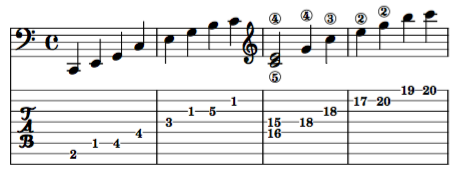Not sure if you mean the two-dimensionality of the grid layout or the two (actually 3) dimensions of pad response. I'll try to address both:
Because the rows are always monotonically chromatic, they're analogous to a fretted string so a linnstrument tuned in, say, fourths can be represented in tab much like an 8 string guitar, e.g.
%% -------------------------------------------------------------------------------------
linnstrument-fourths = \stringTuning <f,, bes,, ees, aes, des ges b e'>
first-two = \relative c, {
c4 e g c |
e4 g b c
}
next-two = \relative c' {
<c\5 e\4>2 g'4\4 c\3 |
e4\2 g\2 b c
}
<<
\new Staff {
\clef bass
\first-two
\clef treble
\next-two
}
\new TabStaff {
\set TabStaff.stringTunings = #linnstrument-fourths
% No open strings on Linnstrument, first pad is fret 1
\set TabStaff.minimumFret = #1
\set TabStaff.restrainOpenStrings = ##t
\first-two \next-two
}
>>
%% -------------------------------------------------------------------------------------

The problem I alluded to in my previous post is that you might well want to play the half-note chord in measure 3 on row 5 as <c\5 e\5>2 (frets 16,20), but LP doesn't seem to support that yet.
There's also an issue if someone wants to arrange the row pitches ascending from back to front. I tried that in the string tuning list and LP didn't do well at keeping the fret numbers low.
Concerning the 3-D pad responses, the typical mapping is:
Z (pressure) --> loudness
X --> pitch bend
Y --> timbre
Those can be handled in standard notation with hairpins for loudness, vibrato, slurs, slides etc for pitch bend, and markup for timbre, e.g. 'sul ponte, sul tasto ...'.
Your image shows it as I expected. But my question remains: if you want that c/e be pressed on one "string" how would you visualize that *at all*? Only with a clear idea about that it's possible to consider a *LilyPond* implementation.
That's a very good question. Since a new convention is required I think it's important to think carefully about what would be most readable and cause the least conflict with existing conventions. I'm leaning toward something very simple, like
---16 20--- whitespace between pad numbers means play simultaneously.
For stemmed tablature, I'd say the stems should attach to the rightmost pad number for up stems and the leftmost for downstems.
Slurs, I suppose, should extend from the leftmost pad that's musically part of the slur to the rightmost.
For glissandi, it may be challenging to cover all possibilities. The Linnstrument permits a slide from any pad to any other in the same row, so there's a need to cover cases like sliding from the center note of 3 pads held down on a row to some other note.